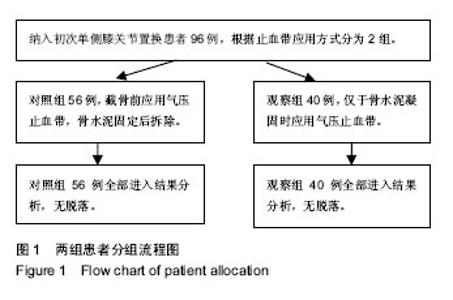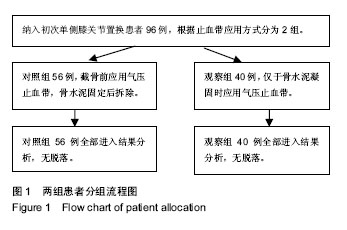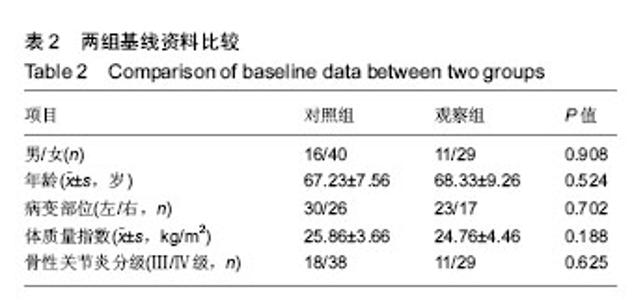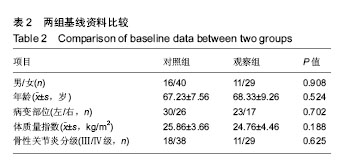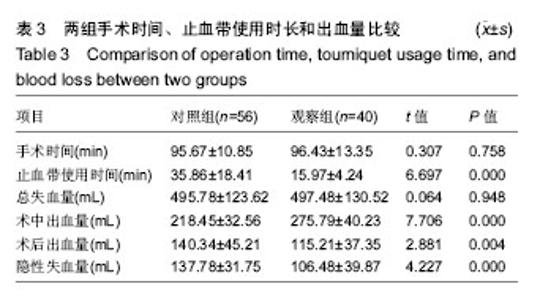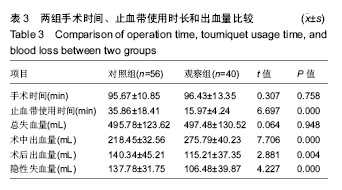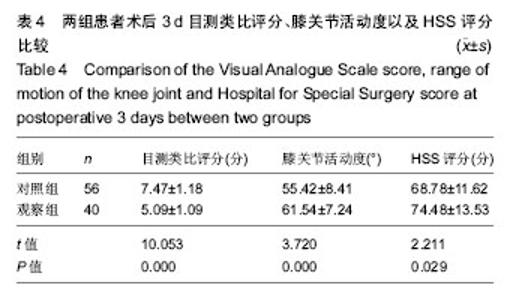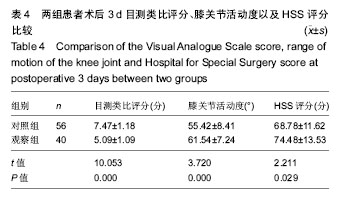Chinese Journal of Tissue Engineering Research ›› 2019, Vol. 23 ›› Issue (20): 3124-3129.doi: 10.3969/j.issn.2095-4344.1233
Previous Articles Next Articles
Optimized use of tourniquet in total knee arthroplasty
Zhao Juntao, Zheng Chengsheng, Wang Bo
- Department of Orthopedics, the People’s Hospital of Hebi, Hebi 458000, Henan Province, China
-
Online:2019-07-18Published:2019-07-18 -
Contact:Zhao Juntao, Department of Orthopedics, the People’s Hospital of Hebi, Hebi 458000, Henan Province, China -
About author:Zhao Juntao, Attending physician, Department of Orthopedics, the People’s Hospital of Hebi, Hebi 458000, Henan Province, China
CLC Number:
Cite this article
Zhao Juntao, Zheng Chengsheng, Wang Bo. Optimized use of tourniquet in total knee arthroplasty [J]. Chinese Journal of Tissue Engineering Research, 2019, 23(20): 3124-3129.
share this article
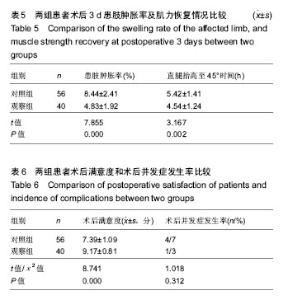
2.6 两组患者术后患肢肿胀率及肌力恢复情况比较 观察组术后3 d患肢肿胀率和直腿抬高至45°时间均少于对照组,差异有显著性意义(P < 0.05),见表5。 2.7 两组患者术后满意度和不良事件比较 观察组术后满意度明显高于对照组,差异有显著性意义(P < 0.05);2组患者术后并发症发生率差异无显著性意义(P > 0.05),见表6。其中对照组患者发生肌间静脉血栓2例、神经麻痹2例,观察组患者发生切口渗出1例,上述并发症经积极对症治疗后症状均消失,无其他并发症发生。 2.8 植入物与宿主的生物相容性 植入物生物相容性良好,2组患者均未出现植入物周围感染、过敏反应、免疫反应及排斥反应。 "
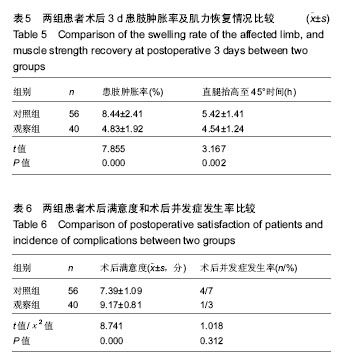
| [1] Smith TO, Hing CB. Is a tourniquet benef icial in total knee replacement surgery? A meta-analysis and systematic review. Knee. 2010;17(2):141-147.[2] Tai TW, Lin CJ, Jou IM,et al. Tourniquet use in totaI kn ee arthroplasty: a meta-analysis. Knee Surg Sports Traumatol Arthrosc. 2011;19(7):1121-1130.[3] 马卫华,张树栋,王诗军,等. 止血带的使用方式对膝关节置换术失血量和手术时间的影响[J].中华关节外科(电子版),2011, 5(6):33-36.[4] Kvederas G, Porvaneckas N, Andrijauskas A, et al. A randomized double-blind clinical trial of tourniquet application strategies for total knee arthroplasty. Knee Surg Sports Traumatol Arthrosc. 2013;21(12):2790-2799.[5] 孙啸,王浩洋,康鹏德. TKA术中不同时机使用止血带对患者造成的损伤比较[J]. 四川大学学报(医学版), 2016, 47(1):135-137.[6] Dennis DA , Kittelson AJ , Yang CC, et al. Does tourniquet use in tka affect recovery of lower extremity strength and function? a randomized trial. Clin Orthop Relat Res. 2016; 474(1):69-77.[7] Jawhar A , Hermanns S , Ponelies N, et al. Tourniquet-induced ischaemia during total knee arthroplasty results in higher proteolytic activities within vastus medialis cells: a randomized clinical trial. Knee Surg Sports Traumatol Arthrosc. 2016;24(10):3313-3321.[8] León-Muñoz VJ, Lisón-Almagro AJ, Hernández-García CH, et al. Silicone ring tourniquet versus pneumatic cuff tourniquet in total knee arthroplasty surgery: A randomised comparative study. J Orthop. 2018;15(2):545-548.[9] Hasanain S, Apostu D, Alrefaee A, et al. Comparing the effect of tourniquet vs. tourniquet-less in simultaneous bilateral total knee replacements. J Arthroplasty. 2018: S0883540318301426.[10] Yang G, Huang W, Xie W. Patellar non-eversion in primary TKA reduces the complication rate. Knee Surg Sports Traumatol Arthrosc. 2016;24(3):921-930.[11] Si HB, Yang TM, Zeng Y, et al. No clear benefit or drawback to the use of closed drainage after primary total knee arthroplasty: a systematic review and meta-analysis. BMC Musculoskelet Disord. 2016;17(1):183.[12] Zhou K, Ling T, Wang H, et al. Influence of tourniquet use in primary total knee arthroplasty with drainage: a prospective randomised controlled trial. J Orthop Surg Res. 2017;12(1): 172.[13] 杜哲. TKA中止血带应对围手术期失血量及近期疗效的影响研究[D]. 济南:山东大学, 2014.[14] Tsunoda K , Sonohata M , Kugisaki H , et al. The effect of air tourniquet on interleukin-6 levels in total knee arthroplasty. Open Orthop J. 2017;11(1):20-28.[15] Matsui Y , Shintani K , Okajima Y, et al. The effect of tourniquets on patellofemoral joint congruity during total knee arthroplasty. J Orthop Sci. 2016;21(5):630-634.[16] Jiang FZ , Zhong HM , Hong YC, et al. Use of a tourniquet in total knee arthroplasty: a systematic review and meta-analysis of randomized controlled trials. J Orthop Sci. 2015;20(1):110-123.[17] Mayer C , Franz A , Harmsen JF , et al. Soft-tissue damage during total knee arthroplasty. J Orthop. 2017;14(3):347-353.[18] Li Z , Liu D , Long G , et al. Association of tourniquet utilization with blood loss, rehabilitation, and complications in Chinese obese patients undergoing total knee arthroplasty. Medicine. 2017;96(49):e9030.[19] Lee O, Lee MC, Han HS. Efficacy and safety of a new elastic tourniquet cuff in total knee arthroplasty: a prospective randomized controlled study. Biomed Eng Online. 2017;16(1): 102.[20] 张炜,陈思锋,李宁,等.止血带对初次全膝关节表面置换作用的Meta分析[J]. 中华关节外科杂志(电子版), 2014, 8(2):215-221.[21] 张元凯,李德强,刘培来,等. 气囊止血带的三种应用方法在TKA的影响分析[C]//中华骨科杂志论坛, 2013.[22] Ozkunt O, Sariyilmaz K, Gemalmaz HC, et al. The effect of tourniquet usage on cement penetration in total knee arthroplasty. Medicine. 2018; 97(4):e9668.[23] Ryu KJ. CORR, Insights®: does tourniquet use in tka affect recovery of lower extremity strength and function? A randomized trial. Clin Orthop Relat Res. 2016;474(1):78-80.[24] Tie K , Hu D , Qi Y , et al. Effects of tourniquet release on total knee arthroplasty. Orthopedics. 2016;39(4):e642-e650.[25] 徐莉莉,林丽娜. TKA术中气囊止血带不同应用时机对出血量、皮肤并发症的影响[J]. 中国现代医生, 2015, 53(31):1-4.[26] Barker T, Rogers VE, Brown KB, et al. Tourniquet use during total knee arthroplasty does not modulate the neutrophil-to- lymphocyte ratio, pain, or activity. J Orthop Traumatol. 2016; 18(3):1-5.[27] Numkanisorn S, Chareancholvanich K, Pornrattanamaneewong C. Intravenous tranexamic acid before and after tourniquet use can reduce blood loss and blood transfusion after total knee arthroplasty. J Med Assoc Thai. 2016;99(11):1220-1225.[28] Dreyer HC. Tourniquet use during knee replacement surgery may contribute to muscle atrophy in older adults. Exerc Sport Sci Rev. 2016;44(2):61-70.[29] Zhang P, Liang Y, He J, et al. Timing of tourniquet release in total knee arthroplasty: A meta-analysis. Orthop J China. 2017;96(17):445-451.[30] 曹学伟,杨伟毅,梁比记,等. 不同止血带使用方法对TKA围手术期失血量影响的临床研究[J]. 中华骨与关节外科杂志, 2011, 4(6):455-459.[31] Chen S, Li JP, Peng H ,et al. The influence of a half-course tourniquet strategy on peri-operative blood loss and early functional recovery in primary total knee arthroplasty. Int Orthop. 2014;38(2):355-359.[32] Ejaz A, Laursen AC, Kappel A, et al. Faster recovery without the use of a tourniquet in total knee arthroplasty. Acta Orthopaedica. 2014;85(4):422-426. |
| [1] | Li Dadi, Zhu Liang, Zheng Li, Zhao Fengchao. Correlation of total knee arthroplasty efficacy with satisfaction and personality characteristics [J]. Chinese Journal of Tissue Engineering Research, 2021, 25(9): 1346-1350. |
| [2] | Wei Wei, Li Jian, Huang Linhai, Lan Mindong, Lu Xianwei, Huang Shaodong. Factors affecting fall fear in the first movement of elderly patients after total knee or hip arthroplasty [J]. Chinese Journal of Tissue Engineering Research, 2021, 25(9): 1351-1355. |
| [3] | Wang Jinjun, Deng Zengfa, Liu Kang, He Zhiyong, Yu Xinping, Liang Jianji, Li Chen, Guo Zhouyang. Hemostatic effect and safety of intravenous drip of tranexamic acid combined with topical application of cocktail containing tranexamic acid in total knee arthroplasty [J]. Chinese Journal of Tissue Engineering Research, 2021, 25(9): 1356-1361. |
| [4] | Lü Zhen, Bai Jinzhu. A prospective study on the application of staged lumbar motion chain rehabilitation based on McKenzie’s technique after lumbar percutaneous transforaminal endoscopic discectomy [J]. Chinese Journal of Tissue Engineering Research, 2021, 25(9): 1398-1403. |
| [5] | Chen Jinping, Li Kui, Chen Qian, Guo Haoran, Zhang Yingbo, Wei Peng. Meta-analysis of the efficacy and safety of tranexamic acid in open spinal surgery [J]. Chinese Journal of Tissue Engineering Research, 2021, 25(9): 1458-1464. |
| [6] | Huang Dengcheng, Wang Zhike, Cao Xuewei. Comparison of the short-term efficacy of extracorporeal shock wave therapy for middle-aged and elderly knee osteoarthritis: a meta-analysis [J]. Chinese Journal of Tissue Engineering Research, 2021, 25(9): 1471-1476. |
| [7] | Gao Yan, Zhao Licong, Zhao Hongzeng, Zhu Yuanyuan, Li Jie, Sang Deen. Alteration of low frequency fluctuation amplitude at brain-resting state in patients with chronic discogenic low back pain [J]. Chinese Journal of Tissue Engineering Research, 2021, 25(8): 1160-1165. |
| [8] | Zhao Zhongyi, Li Yongzhen, Chen Feng, Ji Aiyu. Comparison of total knee arthroplasty and unicompartmental knee arthroplasty in treatment of traumatic osteoarthritis [J]. Chinese Journal of Tissue Engineering Research, 2021, 25(6): 854-859. |
| [9] | Zhang Nianjun, Chen Ru. Analgesic effect of cocktail therapy combined with femoral nerve block on total knee arthroplasty [J]. Chinese Journal of Tissue Engineering Research, 2021, 25(6): 866-872. |
| [10] | Yuan Jun, Yang Jiafu. Hemostatic effect of topical tranexamic acid infiltration in cementless total knee arthroplasty [J]. Chinese Journal of Tissue Engineering Research, 2021, 25(6): 873-877. |
| [11] | Wu Gang, Chen Jianwen, Wang Shilong, Duan Xiaoran, Liu Haijun, Dong Jianfeng. Simple HyProCure subtalar stabilization in treatment of adolescent flexible flatfoot combined with painful accessory navicular bone [J]. Chinese Journal of Tissue Engineering Research, 2021, 25(6): 901-905. |
| [12] | Li Yan, Wang Pei, Deng Donghuan, Yan Wei, Li Lei, Jiang Hongjiang. Electroacupuncture for pain control after total knee arthroplasty: a meta-analysis [J]. Chinese Journal of Tissue Engineering Research, 2021, 25(6): 957-963. |
| [13] | Li Quanxi, Shen Yu, Wan Wei, Sun Shanzhi. Changes of abdominal wall mechanics and pain after tension-free inguinal hernia repair with polypropylene mesh [J]. Chinese Journal of Tissue Engineering Research, 2021, 25(4): 548-552. |
| [14] | Wang Xiaofei, Teng Xueren, Cong Linyan, Zhou Xu, Ma Zhenhua. Herbert screw internal fixation for treating adult osteochondritis dissecans of the knees [J]. Chinese Journal of Tissue Engineering Research, 2021, 25(3): 397-402. |
| [15] | Lü Zexiang, Wu Jutai, Jiang Jian, Feng Xiao, Li Tengfei, Wang Yehua. Effect of tranexamic acid combined with carbazochrome sodium sulfonate on blood loss and safety after total knee arthroplasty [J]. Chinese Journal of Tissue Engineering Research, 2021, 25(3): 386-390. |
| Viewed | ||||||
|
Full text |
|
|||||
|
Abstract |
|
|||||
